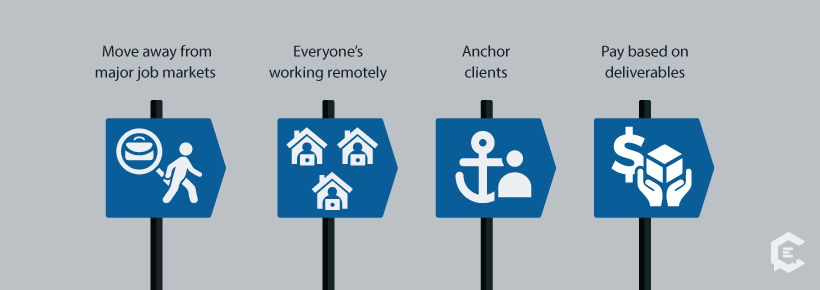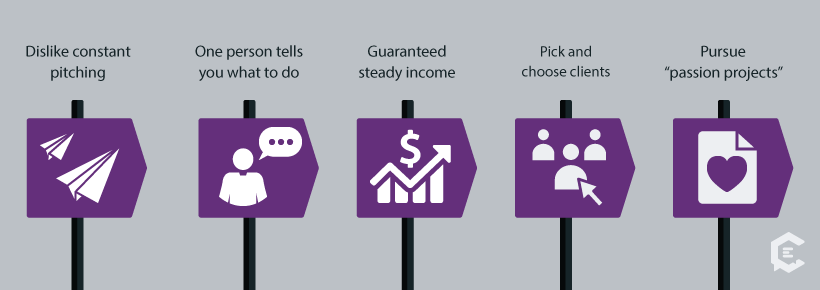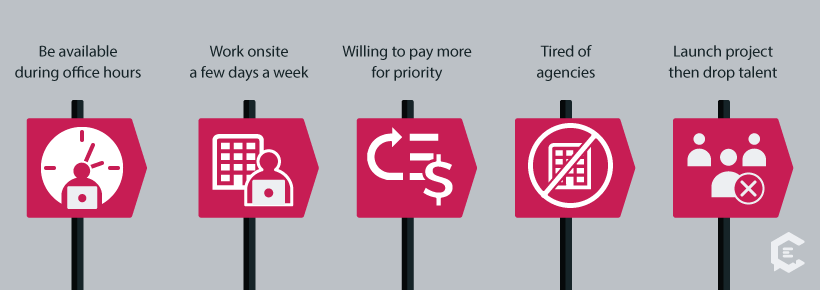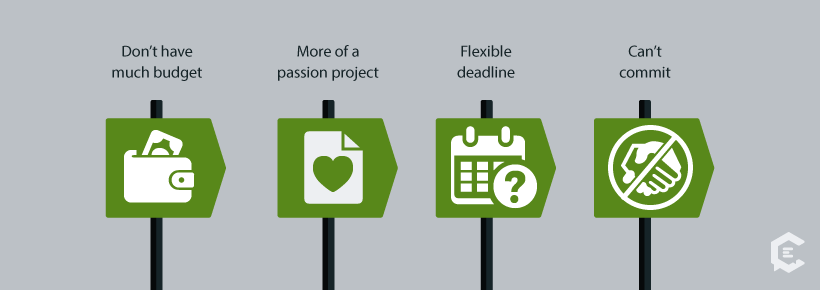Full-time freelancing or moonlighting? It’s a question for both workers and clients. Individuals must determine if full-time freelancing is the right fit for their lifestyle. Clients must figure out if they have the right budget and project for a freelancer, or if they would be better off with a person who moonlights.
Among people who are considering leaving a full-time job to try freelancing or consulting, the most important question is, “How do I know for sure that I’ll be able to support myself financially with freelance work?”
And of course, there is no definite answer — certainly not a permanent one.
Freelancing was, for decades, what people did in the interim when they couldn’t get full-time jobs. But recently, it’s become synonymous with “freedom,” “flexibility” and, oh yes, “necessity,” due to the much-ballyhooed gig economy.
For people who have a full-time job and can’t accept the risk inherent in freelancing, moonlighting has always been the logical solution. But I see a lot of confusion around FT vs. freelance: What’s a better value? What guarantees better work? And what’s actually legal? For the third issue, I truly hope you’ll speak to your legal team. For all the others, here are some handy benchmarks to help you decide what structure works best.
And for clients, if you’re thinking of hiring a freelancer, find pointers to help you decide if you need someone who only freelances or someone who just moonlights as one.
For Talent: Moonlight or Go Full-Time Freelance?
Signs you should go “full-time freelance”
- You’ve moved away from major job markets.
People who cut their teeth in competitive job scenes in San Francisco or New York are often loathe to take the pay cut that comes with salaried jobs in much smaller markets. If you can prove the feasibility of remote work to clients who will listen, FT-freelance can be a much more lucrative solution for you, and a savings for them. - Everyone in your industry has begun to work remotely.
If five out of seven people on a morning meeting are calling in, it’s hard for the VP to make an argument that team members need to be onsite. Many of the wiser supervisors will allow their trusted talent to work remotely, especially if the company is outside a major job market. - You have two or three “anchor clients” that want to give you a few thousand dollars’ worth of work every month.
Experienced freelancers know that one anchor client is worth 10 one-off clients. The anchor client allows you to actually work instead of pitch for paying business; allows you to focus instead of constantly scanning the horizon; allows you most of the things that a salary job does, but without the non-competes and strict office hours. - You prefer to get paid based on deliverables, not time.
A lot of people have no personal drive to get things done quickly. If you instinctively prefer to just get things finished, have them approved, and move on to the next item, you can very likely make more money in a structure that pays you for finishing projects. If you’re moonlighting and find yourself gravitating more to quoting your rates per piece, because you can make more that way than per hour, you probably are suited to a FT freelance career.
Signs that moonlighting is a better fit:
- You don’t like constantly pitching for new business.
A lot of people fall into this category. Pitching is demanding, and rejection is terrible. However, in most creative industries, freelancers must do it constantly in order to stay busy. If it fatigues you or you’re just not good at it, keep your day job. - You prefer if only one person tells you what to do.
The whole “Working for myself and loving it!” Facebook career status is baloney. If you freelance, consult or run an agency, then you treat every single person who works in-house for a client like they’re your boss. If you meet someone at a cocktail party and they tell you they’ve recently been hired and are now your boss — just accept their statement as true until you’re able to veeerry subtly research it. Because they might be your new boss! Also, if you work in production, then the guest talent who is a catfish-tickler from Mississippi is, for the length of the shoot, a VIP and therefore kind of your boss.If you prickle at people bossing you around, freelance is the escape route that’s more likely your worst nightmare. - You prefer a guaranteed steady income to a potentially higher income that changes every month.
Working for one’s self is a roller coaster more often than not. Expect multi-thousand dollar fluctuations from one month to another. Also, remember that the amount you’ve invoiced for is entirely different from the amount you can expect to receive in a month. If this terrifies you — and it should — then reconsider whether you’re ready to leave your day job. - You like to pick and choose clients.
When you’re FT freelance or even consulting, it’s kind of a sign that you’ve made it when you’re able to turn down clients. A lot of people end up taking everything, even if it doesn’t pay well, or isn’t in their area of interest. With a full-time job, you should absolutely give yourself some leeway to only accept the projects or freelance writing jobs that really pique your interest, or those that pay handsomely. - You want to pursue “passion projects.”
Take it from me, sometimes the glamorous life of a creative consultant/freelancer means you want to be writing the script for a groundbreaking national campaign, or pitching an amazing new show, but instead you’re producing a microsite about storm drains. Paying the bills has to take priority over creative pursuits. If you like to compartmentalize your drudge brain that thinks about storm drains, separately of your creative side that’s going to pen an award-winning novel, maybe keep your day job and leave your evenings free for creativity.
For Clients: Work With Full-Time Freelancers or Moonlighters?
Signs someone who is a full-time freelancer is a better fit:
- You want the talent to be available for conference calls and meetings during office hours.
People with day jobs can’t usually step away from those jobs to do other work for mystery clients, and you shouldn’t put them in a position where they need to. Even if they promise that they can. It isn’t sustainable. - You want someone to work onsite a few days a week.
Same situation as above, only to the tenth power. In fact, if you want someone to work onsite several times a week — why don’t you want to make this a salaried position? Just gotta ask… - You’re willing to pay more (hourly or per project) if it means you get priority.
The best consultants and freelancers are in high demand. They prioritize clients, favorite to least favorite — and the client who’s paying the highest usually is near the top. If you hired a freelancer, contractor or consultant because you love their work, then you can stay in the #1 spot by paying just a tiny bit more than everyone else does. - You’re tired of your agencies and want a vendor who is “nimble.”
The best byproduct of the “gig economy,” if you ask me, is that companies are beginning to look at freelancers , or rather one-man shops, as an alternative to the big agencies they used historically. If you’re a client who likes to run a lot of test campaigns, make last-second changes to social content, or execute quick-turnaround projects, you’ll probably find that a top-tier freelancer/independent is better able to do this than an agency is. - You need to launch a product or initiative on a strict timeline… and then drop 50% of the talent who executed the launch.
For many talent, this is the worst possible work scenario. They give 110%, and then after a triumphant launch… Congratulations, they’re fired! Career freelancers are used to the pattern, however, and will negotiate themselves a contract that ensures they’re paid appropriately during the intense phase — and are prepared for the project to taper off once work is complete.
Signs that a moonlighter would be a better fit:
- You don’t have much budget.
You know the saying: “Good, cheap and fast. You can have two out of three.” If you want good work and you don’t have much budget, then speed is what you sacrifice. Find a freelancer who excels at their day gig and has extra bandwidth for yours. - This is more of a passion project for you, too.
The thing about passion projects is, they’re blissful for the soul when they’re clicking, but they don’t pay the bills. As discussed up top, freelancers often moonlight because they want to pursue their own passion projects. If there’s alignment between you, that’s great. Just don’t ask them to deliver you a 3-month plan. - Your deadlines are flexible.
Further to what I said. Even if you run a successful company with deadlines like clockwork — if you’re hiring a part-timer to do something in their available hours, and especially if your budget is minimal, don’t put them on rigorous deadlines. It’s not realistic. - You would consider freelance-to-fulltime, but you can’t commit.
Freelance-to-fulltime is a professional getting-to-know-you process. The thing is, most career independents (freelance, consultants, etc.) do not actually WANT to go in-house. They want to keep their freedom. People who moonlight are also having a tough time figuring out whether to commit, so they’ll be more open-minded to this structure. And if it doesn’t work out, they’ll still have their day job.







